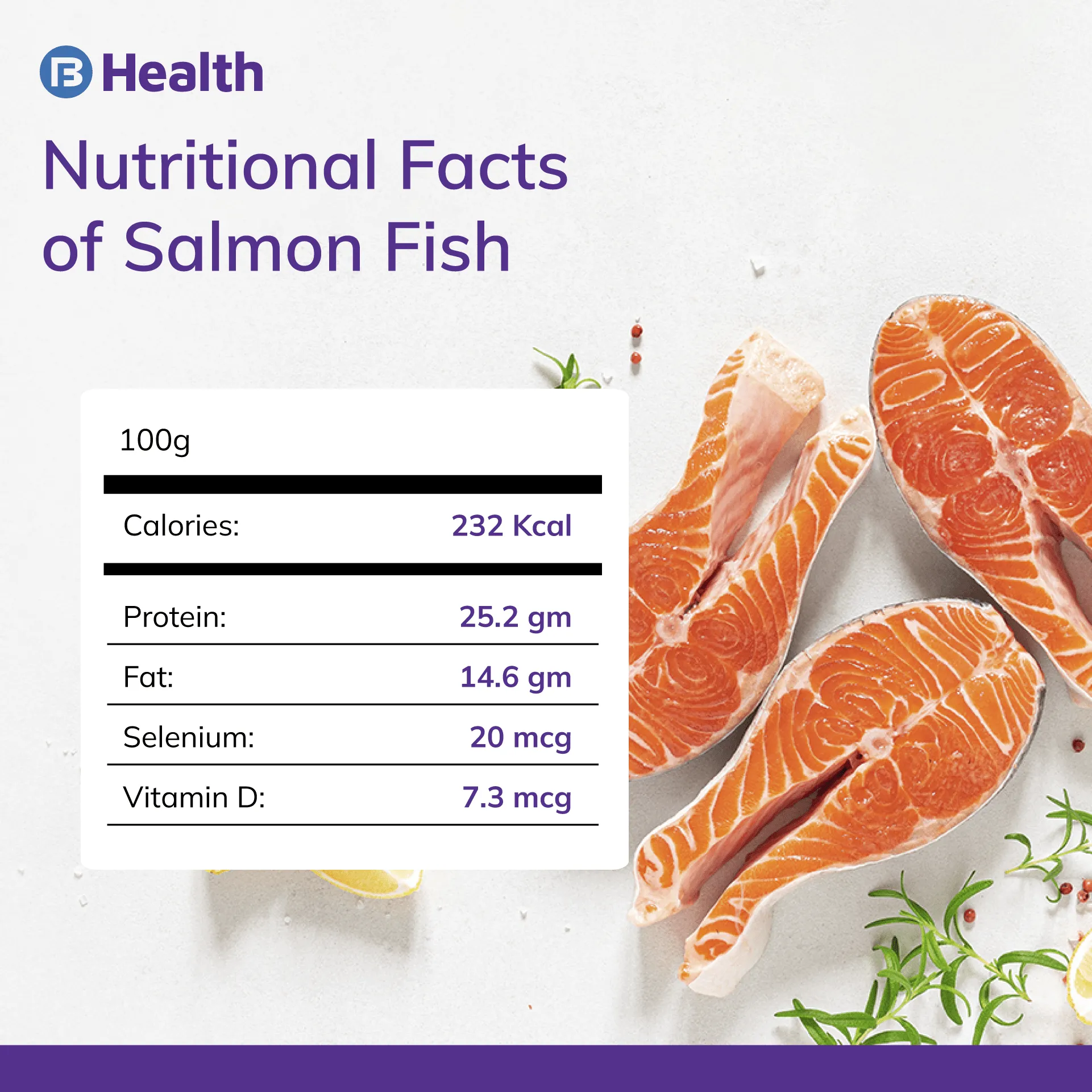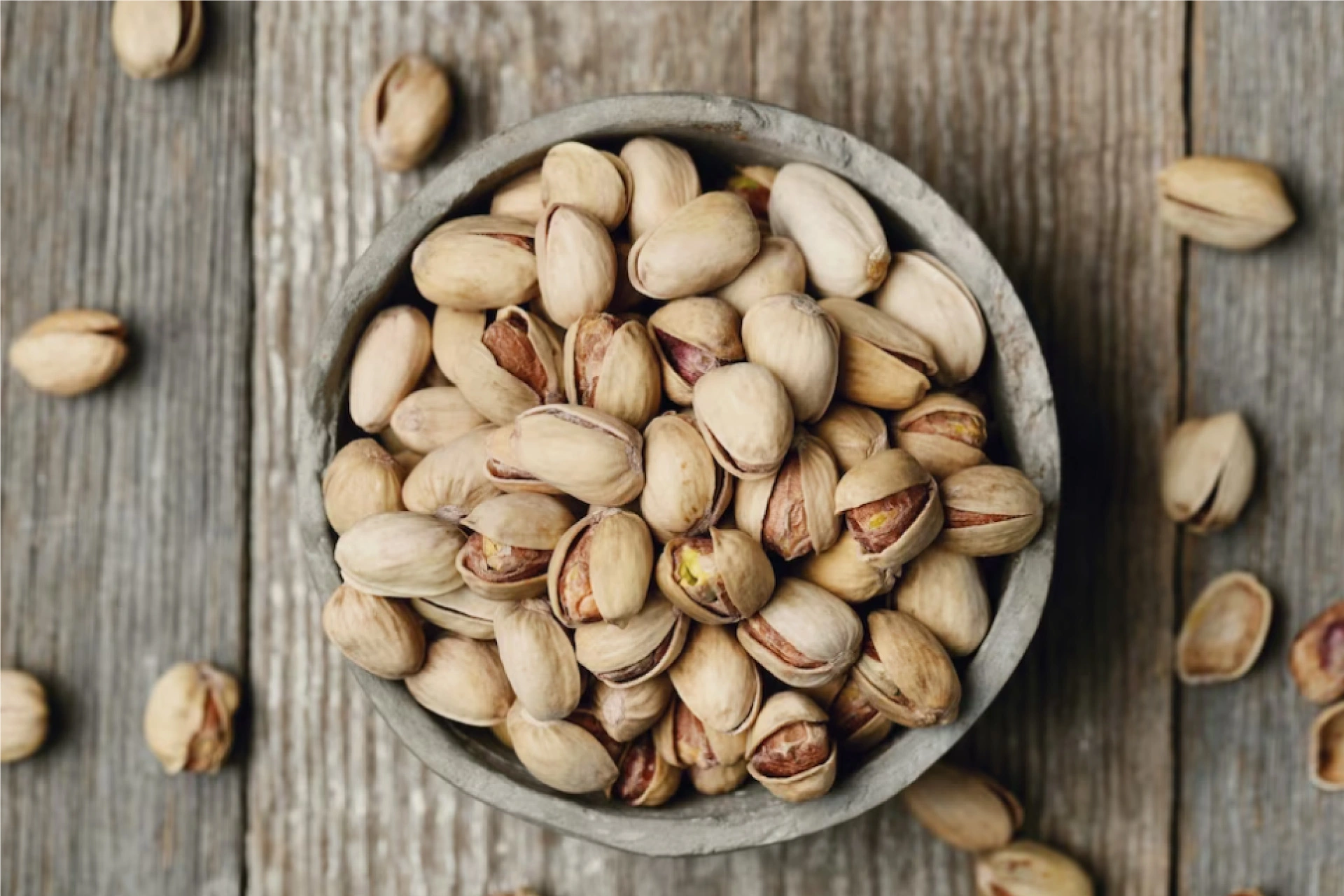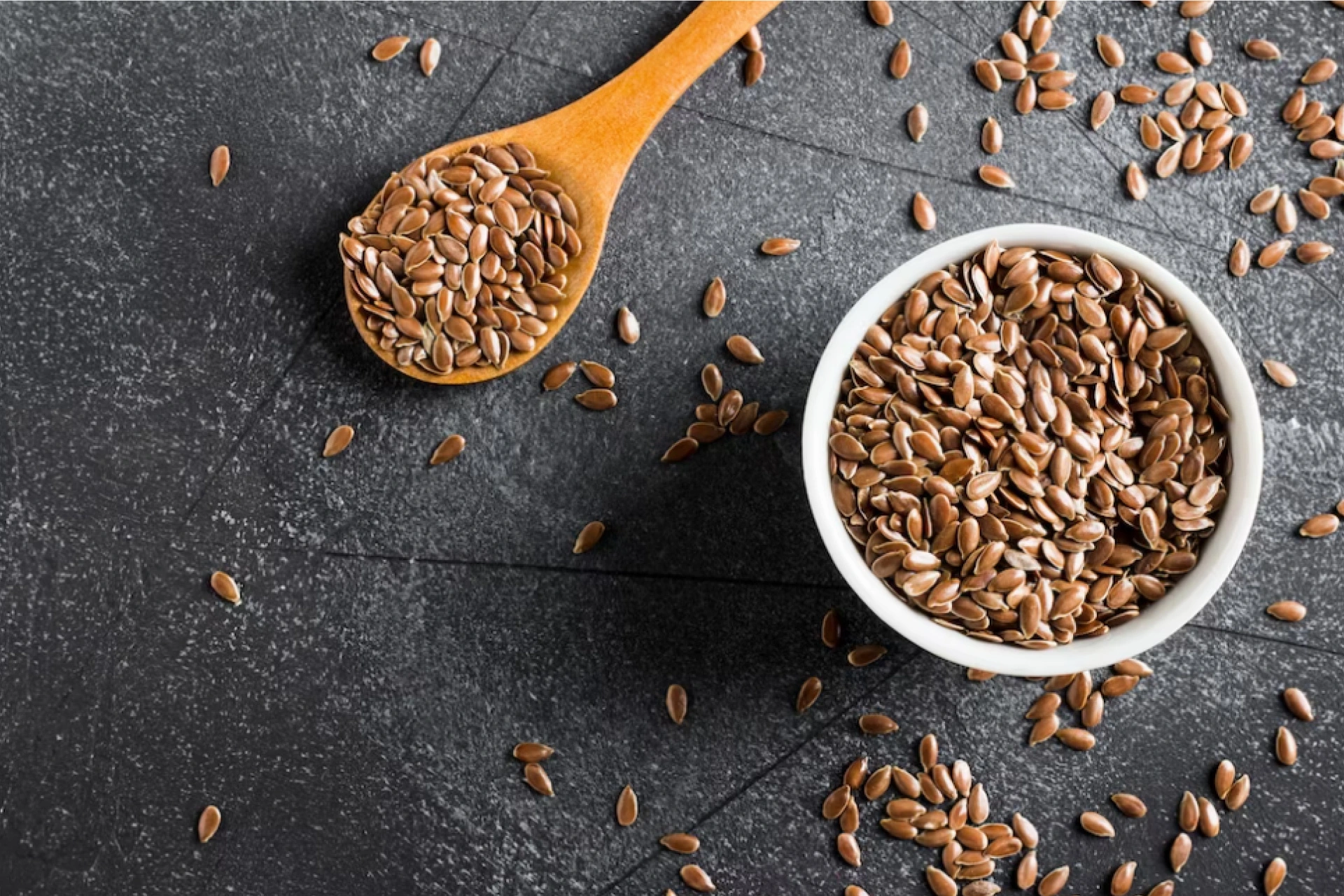Nutrition | 9 min read
Salmon Fish: Nutritional Value, Benefits and Health Risk
Medically reviewed by
Table of Content
Key Takeaways
- Add salmon fish to your diet to enjoy powerful health benefits
- Salmon fish is rich in protein, selenium, and B vitamins
- Salmon fish oil benefits your brain, heart, and skin health
Salmon fish is one of the fatty fish that offers loads of health benefits. It is rich in protein, omega-3 fatty acids, omega-6 fatty acids, vitamins, and minerals. This high protein food is also rich in antioxidants including selenium, phosphorus, zinc, potassium, and B vitamins such as vitamin B6, B12, folate, and riboflavin. Adding it to your diet can help you meet your daily intake of essential vitamins and minerals.
This nutritious superfood offers a great taste along with versatile health benefits. In fact, consuming fatty fish like salmon reduces the mortality rate from heart diseases [1]. Salmon fish benefits your hair and skin as it contains healthy fats. Read on to know more about salmon fish-eating benefits.
Nutritional Value of Salmon Fish
- Energy: 127 kcal
- Fats: 4.4g
- Salt: 37.4 mg
- 0g of carbohydrates
- 20.5g of protein
- Fibre:0g
These nutritional values may change depending on the kind of salmon fish. It is a healthy fish option since all the species act as nutritional reserves.
- Salmon fish has a lot of protein and no carbohydrates. They are permitted to consume up to 21.9g of fish protein, which has outstanding health benefits. But compared to wild salmon, which is leaner, farmed salmon has a greater fat level and includes more saturated fat.
- Salmon is a good source of vitamin A and several B complex vitamins. Additionally, it is one of the few naturally occurring dietary sources of vitamin D (particularly wild salmon).
- Salmon fish is a wonderful source of calcium and other nutrients since its bones are edible. Among these minerals are magnesium, phosphorus, potassium, zinc, and selenium.
Salmon Fish Benefits
Salmon offers outstanding health advantages since it contains so many important minerals, fish oils, fatty acids, and fish protein:
Reduce Your Chances of Osteoporosis
Decreased bone density is a side effect of osteoporosis. The bones start to crack. It increases the likelihood that they might get unexpected fractures from a little fall or accident. Salmon fish's edible bones and inherent vitamin D content make it a superior calcium source. Our bodies are guaranteed to absorb the calcium we ingest, thanks to vitamin D.
Our calcium-based skeletal system supports our entire body.
Our bodies are guaranteed to absorb the calcium we ingest, thanks to vitamin D.
Our entire body is supported by our calcium-based skeletal system. Consequently, a calcium deficit may be dangerous. Calcium and vitamin D, on the other hand, support the skeleton's structure. As a result, it lessens the possibility of getting osteoporosis.
Encourages a Healthy Pregnancy
Salmon fish contains Omega-3 and Omega-6 fatty acids, making it an excellent meal complement for pregnant women. According to the study, proper ingestion of omega-3 fatty acids is critical during pregnancy. This is due to the fact that omega-3 fatty acids are essential building blocks for the unborn brain and retina. They also aid in the prevention of perinatal depression.
Salmon fish has extremely little mercury when compared to other major fish species. This makes it safer for pregnant women to ingest without jeopardizing the health of the baby or the mother. Simultaneously, the fish supplies other critical elements, as well as fish protein.
Enhances Vision
Vitamin A is required for good vision. Salmon is a vitamin A repository and a wonderful source of vitamin A. It can assist in enhancing vision and increasing general wellness. Vitamin A also aids in the function of the cornea, the eye's protective outer layer. It can assist in enhancing vision and increase general wellness. Vitamin A also aids in the function of the cornea, the eye's protective outer layer.
Vitamin A is a precursor for a photopigment that is located in the inner eye membrane cells. As a result, consuming a vitamin A-rich diet aids in the operation of these cells, which are responsible for sharper eyesight.
A 100g serving of raw fish contains 50IU of vitamin A. As a result, it contributes to better eye health.
Promoting Cardiovascular Health
Eating salmon fish on regular basis can prevent ailments related to the heart including heart attacks, hypertension, strokes, and high triglycerides. This fish is rich in potassium and omega-3 fatty acids. These fats and minerals promote heart health. They help you maintain blood pressure levels, reduce inflammation of the arteries, and lower cholesterol. Potassium can also prevent excess fluid retention. A review suggests that consuming fish may have a positive effect on reducing the risk of cardiovascular diseases [2].
Maintaining Body Weight
The fat content in salmon fish doesn’t add pounds. The oily fish may help you lose weight and thus prevent obesity. This protein-rich food improves satiety and controls your weight by regulating the hormones responsible for your appetite [3]. Intake of fish oil supplements may also reduce abdominal fat in obese people [4]. Adding salmon to your diet is especially beneficial as you can meet various vitamin and mineral deficiencies with it.
Improving Brain Health
Salmon fish is great brain food, thanks to its rich omega-3 content. It helps improve your brain memory and retention. The fatty acids in salmon along with vitamin A, vitamin D, and selenium boosts brain function. Oily fish is also associated with a decreased risk of dementia. In fact, supplements of omega-3 fatty acids are used in the treatment of Alzheimer’s and Parkinson’s disease.
Fatty fish can reduce the symptoms of anxiety and depression, improve fetal brain health, and slow age-related memory loss. Consuming at least one serving of fish per week decreases the rate of cognitive decline in older adults [5].
Fighting Inflammation
Inflammation is a cause of several chronic diseases such as diabetes, cancer, and cardiovascular diseases [6]. Salmon fish is one of the recommended foods due to its anti-inflammatory properties. The omega-3 fatty acids in salmon can reduce osteoarthritis and other inflammatory joint conditions. A recent study suggested that consuming fish can lower the levels of peripheral white blood cell (WBC) counts, a marker of chronic inflammation [7].
Lowering Blood Pressure
Eating salmon may be beneficial for people with hypertension as it helps lower blood pressure. Salmon fish is extremely rich in omega-3 fatty acids. These fatty acids along with selenium content can lower blood pressure, bad cholesterol, and inflammation. This can further reduce the risk of heart disease. Eating salmon can also improve your cardio-muscular health.
Boosting Thyroid Function
Salmon contains a considerable amount of selenium. This essential mineral helps maintain proper thyroid function. It protects your thyroid gland from oxidative stress. Proper thyroid function is necessary for supporting your other body functions. So, make sure to include salmon fish in your diet.
Improving Skin Health
The fatty acids and vitamin A in salmon fish can boost your skin health and make you look radiant. Omega-3 fatty acids and carotenoid antioxidants in the fish help prevent damage to cells by free radicals, thus slowing down aging. The fatty acids can add moisture, smoothen the skin, and make you look younger.

Salmon Fish Healthy Recipes
1. Avocados Stuffed with Salmon
- Servings: Four4
- Time to cook: 15 minutes for preparation
Ingredients
- Two chunks of avocados
- 5 ounces of salmon (in a can, drained and flaked) without the skin and bones
- 1/8 teaspoon ground pepper
- 1/8 teaspoon of salt
- One teaspoon mustard
- Two tablespoons of no-fat mayo
- Two tablespoons. of parsley
- Greek yogurt: 12 cups diced celery
- One tablespoon of lime juice
- Chives, chopped, as a garnish
Method of Preparation
- In a medium bowl, combine the yogurt, celery, parsley, lime juice, mayonnaise, mustard, salt, and pepper
- When ready, stir in the fish
- Remove the pits from the avocados and cut them in half lengthwise
- Remove about one spoonful of flesh from each avocado half and place it in a small basin
- With a fork, mash the avocado flesh that has been removed and incorporate it into the mixture
- Place a heaping 14 cups of the mixture in the centre of each avocado half before serving
- You may pack the dish for your kids' lunches or have it as an evening snack
2. Sweet and Tangy Salmon with Green Beans
- Servings: Four4
- Time spent preparing: 45 min
Ingredients
- Four salmon fillets (6 ounces each)
- One tablespoon butter
- Two tablespoons brown sugar
- One tablespoon of soy sauce
- One tablespoon of mustard
- One tablespoon of olive oil
- 12 teaspoons of pepper
- 1/8 teaspoon of salt
- Fresh green beans, 500 grams (trimmed)
Method of Preparation
- First, preheat the oven to 218 degrees Celsius to cook the fish
- Put the fillets in a baking dish with cooking spray on it
- Brown sugar, soy sauce, mustard, oil, pepper, and salt are stirred into melted butter. Use half of this mixture to brush the fish with
- Place the green beans in a large bowl and coat them with the remaining brown sugar mixture
- Put green beans all around the fillets. Green beans should be crisp-tender, and the fish should start flaking readily with a fork after roasting for 14–16 minutes
3. Rice Bowl Salmon
- Four servings
- Time to cook: 15 minutes for preparation
Ingredients
- Four salmon fillets
- 120 ml of sesame-ginger salad dressing
- 400 g of cooked brown rice
- 120 g of parsley, chopped
- 1/4 teaspoon of salt
- Carrots julienned: 128 g
- Sliced cabbage, thin
Method of Preparation
- The oven should be heated to 218 degrees Celsius
- Salmon should be placed in a foil-lined skillet and brushed with 1/4 cup of dressing
- For about 8 to 10 minutes, bake the fish until it just starts to flake easily with a fork
- In the meantime, combine the salt, parsley, and rice in a basin
- Divide the mixture and, if preferred, the cabbage before serving
- Add the remaining dressing and drizzle
Health Risks of Eating salmon
Salmon is a meal that is rich in nutrients and may be a fantastic complement to a balanced diet, but there are certain drawbacks and hazards to take into account.
To start, both wild and farmed salmon frequently include toxins like polychlorinated biphenyls (PCBs) and dioxin, which, if taken in large quantities, can change hormone levels and have a severe impact on other areas of health.
One must follow the government rules on the number of contaminants allowed in feed to lessen the number of pollutants in seafood.
Additionally, the diet for farmed fish frequently contains antibiotics. The overuse of antibiotics is linked to environmental issues, raises the possibility of antibiotic resistance, and has additional long-term health consequences.
If you are worried about antibiotic resistance, it may be best to stay away from fish from nations with laxer antibiotic usage laws, like Chile.
Furthermore, bear in mind that salmon contains some mercury, but considerably less than other species like swordfish and shark.
In general, it's advised that pregnant women have 2-3 portions of fatty fish per week and steer clear of raw or undercooked seafood.
Additional Read: 6 Top Everyday Superfoods Daily MealsNow you know how this fish and salmon fish oil benefits your health in different ways. So, it is time to make this vitamin B-rich food a part of your diet. You can also take salmon fish oil capsules if you like. For detailed advice, book an online doctor consultation on Bajaj Finserv Health. Consult with the best dieticians who will help you with a personalized plan to boost your health.
References
- https://www.hsph.harvard.edu/nutritionsource/fish/
- https://pubmed.ncbi.nlm.nih.gov/29420061/
- https://www.ncbi.nlm.nih.gov/pmc/articles/PMC4258944/
- https://pubmed.ncbi.nlm.nih.gov/26571503/
- https://www.ncbi.nlm.nih.gov/pmc/articles/PMC4162477/
- https://www.ncbi.nlm.nih.gov/books/NBK493173/
- https://pubmed.ncbi.nlm.nih.gov/33411013/
Disclaimer
Please note that this article is solely meant for informational purposes and Bajaj Finserv Health Limited (“BFHL”) does not shoulder any responsibility of the views/advice/information expressed/given by the writer/reviewer/originator. This article should not be considered as a substitute for any medical advice, diagnosis or treatment. Always consult with your trusted physician/qualified healthcare professional to evaluate your medical condition. The above article has been reviewed by a qualified doctor and BFHL is not responsible for any damages for any information or services provided by any third party.






